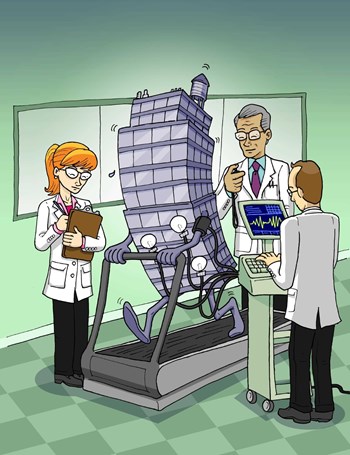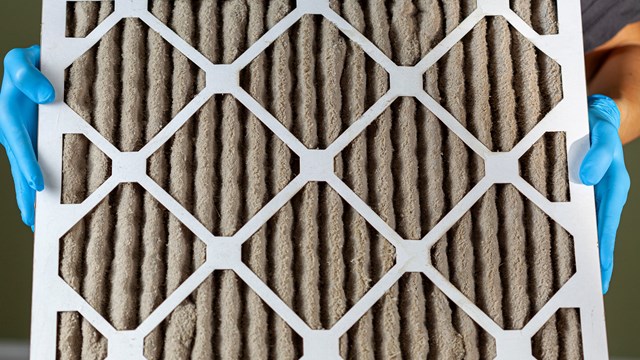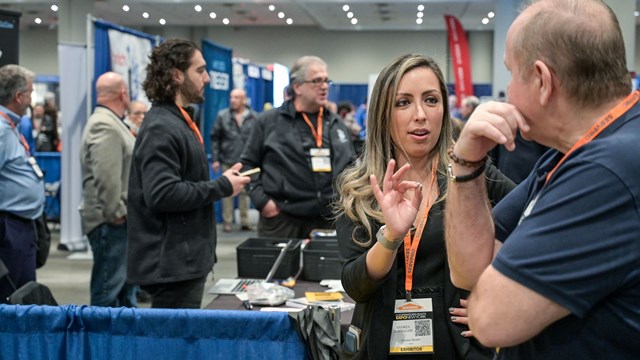
The term Sick Building Syndrome was first used in the late 1970’s after a mysterious outbreak of pneumonia occurred among people attending an American Legion convention in a well known Philadelphia hotel. Thirty four deaths were reported and 221 people required medical treatment.
Sick Building Syndrome (SBS) is not a specific disease but rather an association of several clinically recognizable features when the symptoms of a significant number of a building's residents are shared. SBS can be caused by several underlying factors. Each cause will result in a specific effect, requiring identification and a treatment plan that eliminates the problem and prevents future episodes. An entirely new industry has sprung up which attempts to identify, isolate, and remove the cause when a building is diagnosed with SBS, and the human inhabitants are adversely affected.
The U.S. Centers for Disease Control and Prevention (CDC) mounted an unprecedented investigation into the American Legion convention outbreak. The focus shifted from an outside cause, such as a human disease carrier, to the Bellevue-Stratford Hotel itself, when the CDC identified and isolated a previously unknown strain of bacteria. It was found breeding in the cooling tower of the hotel’s air conditioning system and spread easily throughout the entire building.
The bacteria, subsequently named Legionella after the convention that triggered its discovery, caused what is now known as Legionnaires Disease. In January 1977, the world became aware that buildings could become 'sick' and spread disease to humans, sometimes with fatal results. These findings prompted new regulations worldwide for climate control systems.
Air-Tight Buildings
SBS is more about ventilation than a specific style or type of building. For example, air-tight buildings conserve energy, are easier to heat and cool and here in Florida an air-tight structure is more resistant to hurricane force winds; all good points for condo dwellers, but there is a flip-side to be considered. An air-tight dwelling does not allow a structure to 'breathe,' and the circulation of stale, sealed-in air can quickly lead to deteriorated indoor air quality (IAQ), one of the main factors for SBS. The degree of deterioration depends on many things. Cleaning products, dust, cooking odors, pets, humidity, insecticide dust, pollen, mold spores, tobacco smoke, airborne bacteria and viruses are all pollutants that range from annoying to deadly. Carpeting, upholstery, electronic equipment, copy machines and pesticides also emit volatile organic compounds (VOCs) which enter the ventilation system of a building and eventually the lungs of its inhabitants. Pollutants from vehicles or combustible products may enter a dwelling from poorly located air intake vents, open windows, or even plumbing vents.
According to the Environmental Protection Agency (EPA), your exposure to air pollutants can be up to 100 times higher indoors than outdoors. The American Lung Association estimates that most people spend 90 percent of their time indoors; in light of that, the importance of clean air (as well as perhaps stepping outside once in a while) cannot be overstated.
Cause and Effect
How much ventilation is adequate, and how does a property management company or a condo owners’ association determine and meet the requirements for indoor air quality?
The American Society of Heating Refrigerating & Air Conditioning Engineers (ASHRAE) recently revised ventilation standards in place since 1973. Guidelines now call for 15 cubic feet per minute (cfm) of outside air for each building occupant to ensure indoor air quality. Installing or upgrading heating and air conditioning units may be required to meet current guidelines. An indoor air quality inspection is the best way to determine current status or to investigate a suspected problem.
Service Manager Joe Massa of Ierna’s Heating & Cooling in Pasco County explains the steps and procedures involved in an IAQ inspection. “It generally begins with a walk-through inspection of the area to provide information about factors that influence indoor air quality,” Massa states. “Prior to the walk-through, information about the building’s history, and HVAC zones should be assembled by key individuals,” he explains. The walk-through itself will allow for a visual inspection of critical areas and a chance to consult with management, occupants and staff.”
Massa indicates that while air sampling might seem like a logical approach to discovering a contaminant, the sample will seldom provide information about the cause. That valuable information may be discovered with routine maintenance and inspections. SBS is a cause-and-effect scenario, the effect is often obvious, but is only a symptom of the underlying problem.
Massa has been with Ierna for six years, and is a proponent of annual inspections and routine maintenance. Duct inspections can reveal leaks or the need for other repairs. A leaky duct is both an energy and a health concern; leaking air raises utility expenses and also allows contaminants to enter the HVAC system. Drain lines must be serviced and routine changing of filters is one of the easiest and best ways to improve IAQ, he says.
Using the proper filters is probably the least expensive way to impact air quality. Residents can be proactive by changing the filters in their individual units regularly. Choosing the correct filter may be a challenge; once the proper size is determined the choices are numerous. Filters are rated on the MERV system (Minimum Efficiency Reporting Value) created by ASHRAE. Robert Cohen, CIS (a certified indoor air specialist) and CEO of Florida Key Pure Air Systems on Big Pine Key, recommends only using filters with a high MERV rating.
MERV ratings of nine to 12 are a great choice for homeowners who want the best dust control possible. The most efficient filters have MERV ratings of 13 to 16 and will stop particles as small as .3 microns. These filters are used in hospitals and other super-clean environments.
“The Florida Keys have a high concentration of coral, and coral dust can be a lung irritant,” says Cohen. “So the higher the MERV, the better. I suggest using the computer to set a reminder to change the filters, and I recommend monthly changes.”
Cohen also recommends an air purification system because it destroys ozone, a known lung irritant. “Most condominiums over three or four years old will not have an air purification system as part of the original physical plant, but these systems can be added.” Typically they use UVA-light technology to attack all three classes of indoor air contaminants–particles, mold/mildew/bacteria, odors, and chemical vapors.
Filter usage and air quality are all in a day’s work, but those are not the biggest problem Cohen deals with. The heat and humidity in South Florida provides a perfect breeding ground for the problem he sees the most…mold.
Mold infestation is often present in SBS. There are more than 160 different species of mold, none are desirable in a home or business and at least 16 species have been documented as causing human disease through carcinogens and immuno-suppressive toxins. Infections, breathing difficulties, skin irritations, and flu-like symptoms, are only a partial list of mold induced illness. Certain species of black mold are deadly. Cohen is a member of NORMI (National Organization of Remediators and Mold Inspectors), and has completed the extensive training offered by this organization. NORMI trains and certifies professionals in the mold abatement industry, as well as in the field of IAQ, drinking water, and biological contaminants. These cooperative groups of professionals are considered experts in their field and a listing can be found at www.normi.org.
Mold is not a new problem. The first recorded reference to mold is in the Old Testament of the Bible, Leviticus 14:37-45. The reference deals with how to treat a home with a mold infestation, in two parts. If the first treatment is not a success, Biblical scholars recommend destroying the building.
Different methods are used by today’s professionals to defeat this centuries-old enemy. Cohen always starts his investigations with a visual inspection. He checks for condensation on the vents, and black spots on the baseboards and door jams. Based on the visual, he then obtains building plans or blueprints and takes air samples at strategic locations. Water leaks are often at fault, and if the problem has been ignored or undiscovered for an extended period of time, mold remediation may be necessary. It is necessary to identify the mold in order to gauge the danger to humans and to treat it effectively.
If you suspect mold in your unit or building, call in the experts. A musty smell may be your first clue, since mold often starts and grows in unseen spaces. All trained professionals agree, the source of the problem must be located and repaired. Mold issues are rarely if ever a DIY project, although the EPA guidelines state that any area under 10 square feet can be handled by routine maintenance crews. Regular household products will not eradicate the problem. “Bleach and chlorine will not kill mold,” states Steve Whallen, a CMA, (a certified mold assessor) and CMI (a certified mold inspector) in the greater Tampa Bay Area. “Bleach destroys the color and retards the growth, but this single cell organism is smart enough to know it is being attacked.” “The flowering part of the mold folds over the stem, and after a dormant time, the mold will grow back,” Whallen explains. “It takes a professional to eradicate mold.”
Peter Romano, CIEC (a certified indoor environmental consultant), CMC (a certified microbial consultant), and the president of Florida Mold Inspection, Inc., knows that is true. Remediation may require a building to be taken back to the studs; costly in time, and resources. “Building products do not dry out as fast now, as in the past,” states Romano, “and that fact contributes to mold and mildew issues.” He recommends all property management offices maintain a MDSS (Material Data Safety Sheet) for cleaning products, most often responsible for VOC pollutants and a major culprit affecting IAQ.
Romano deals with less serious issues too. He cites one office that had four people in a 12-x-12 space with computers, copiers, and other office equipment. No surprise when the staff complained of headaches, being lethargic, and suspected SBS. The carbon dioxide (CO2) generated from the office equipment was not able to dissipate in the confined area. Relocation of staff and equipment was an easy fix.
Whallen, who has eight years experience as a CMA and a CMI, says he has encountered his share of SBS scenarios. Between 2001 and 2009 Chinese drywall was used in new construction and repairs in the Bay area. The fallout from this toxic building product is still evident today. Whallen references a front page story in the July 15, 2011 of The Tampa Tribune. Yet another homeowner has brought a story of inferior products and builder irresponsibility to the press. A gas emitted from the drywall corrodes electrical wires, destroys electronics, tarnishes silver and endangers health. Some builders have made costly repairs while others have completely gone out of business leaving owners with a home they can neither live in nor afford to repair. Fixing legal and financial responsibility will not be an easy task for many of the homeowners involved.
Mary Doe*, in central Florida knows all too well how difficult it is to bring suit on a SBS issue. A decade ago she purchased a small condo, perfect for her needs as a single professional. She had a motivated real estate agent, a recommended home inspector, and a signed deal in record time. [*Editor’s note: name has been changed in interest of privacy].
Within four months of moving into her condo, Doe received alarming medical news at a regular physical. She had contracted a fungal infection and a blood infection, and while she hadn’t begun to feel seriously ill, both infections were resistant to treatment.
Shortly after that medical visit, she discovered a large damp spot on her upstairs ceiling. As Doe examined the area it suddenly gave way, leaving a gaping hole in the ceiling and revealing wet sheetrock and insulation from an unrepaired roof leak. Something even more sinister was soon revealed, Aspergillus mold, which was the source of her infections. Doe immediately sought out her property management company, the HOA, and the COA for repairs. She was shocked to find not only resistance to her request for maintenance, but outright hostility from key board members. She was accused of inflicting the damage herself, but forbidden from making repairs because of the common roof. As the mold spores spread in the condo and her health deteriorated rapidly, Doe moved in with a friend and sought legal counsel.
The suit was settled in Doe’s favor. The property management company was put out of business, and the COA and HOA paid heavy fines. Doe lost all of her belongings and home furnishings, and acquired life-long health issues from the mold. Doe had the condo remediated—it was gutted to the studs—and certified clean; she was unwilling to pass such a serious problem on to another unsuspecting owner. The condo has since sold, and new property management is in place. But there were no winners in this case.
This unfortunate situation makes one thing very clear. Inspections and preventive maintenance are vitally necessary to keep your most important investment—your home—in tip-top shape.
Anne Childers is a freelance writer and a frequent contributor to The South Florida Cooperator.






3 Comments
Leave a Comment